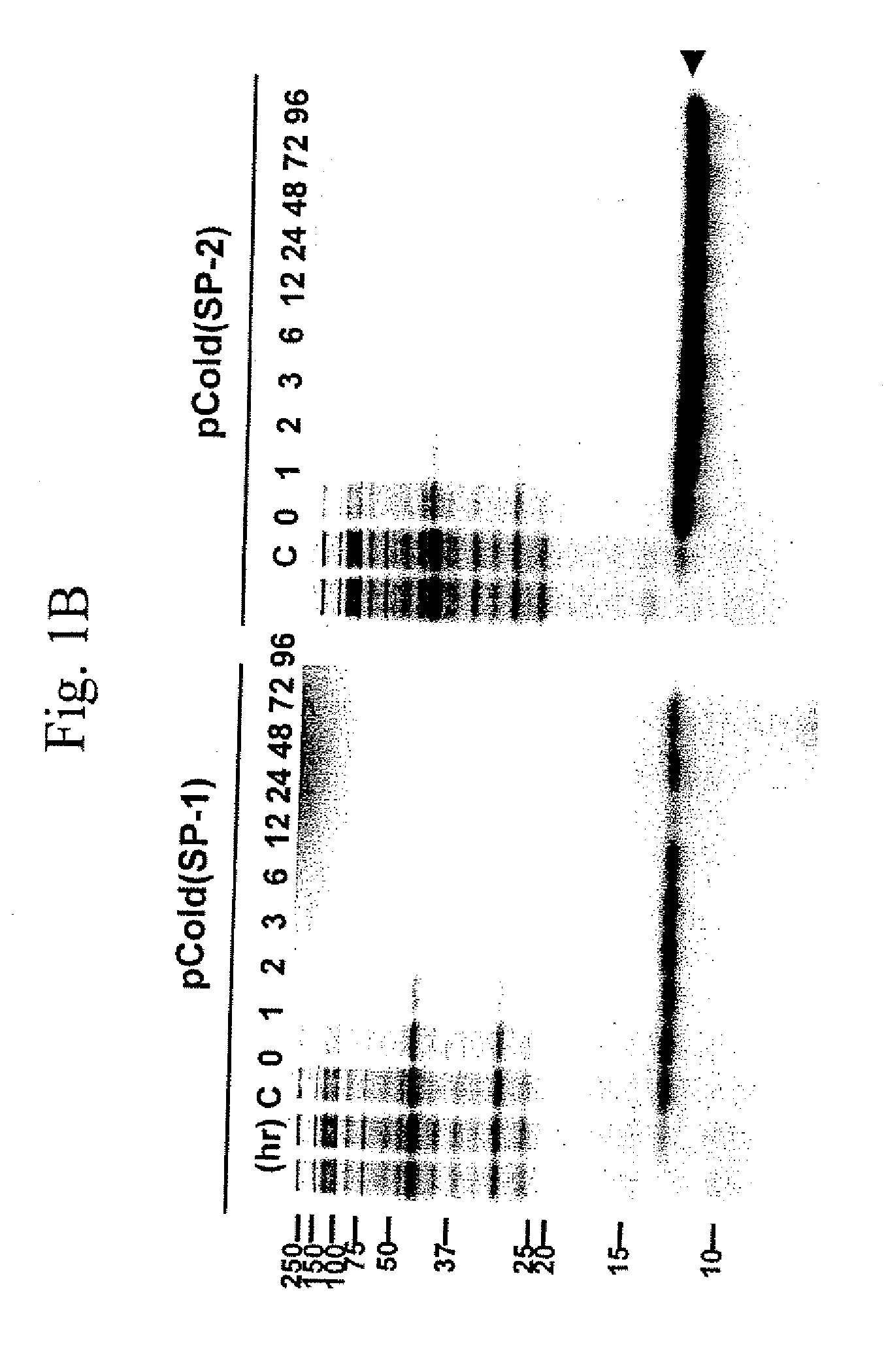Single protein production in living cells facilitated by a messenger RNA interferase
a technology of living cells and interferase, which is applied in the direction of hydrolases, biochemical apparatus and processes, microorganisms, etc., can solve the problems of cell death and severe reduction of protein synthesis, and achieve the effect of high protein expression and stable maintenan
- Summary
- Abstract
- Description
- Claims
- Application Information
AI Technical Summary
Benefits of technology
Problems solved by technology
Method used
Image
Examples
example 1
Effects of MazF Induction of Cellular Protein Synthesis
[0073]E. coli BL21(DE3) carrying pACYCmazF was transformed either with pColdI(SP-1)eotaxin (A and left panel in B) or pColdI(SP-2)eotaxin (right panel in B and C). Cells were grown in M9 medium at 37° C. At OD600 of 0.5, the cultures were shifted to 15° C. and after incubation at 15° C. for 45 min to make cells acclimate low temperature, IPTG (1 mM) was added to induce both eotaxin and MazF expression (0 time). Cells were pulse-labeled with 35S-methionine for 15 min at the time points indicated on top of each gel and total cellular proteins were analyzed by SDS-polyacrylaminde gel electrophoresis (PAGE) followed by autoradiography.
[0074]The mazF gene was cloned into pACYC, a low copy number plasmid containing an IPTG inducible phage T7 promoter, yielding pACYCmazF. Cloning techniques generally may be found in J. Sambrook and D. W. Russell, Molecular Cloning: A Laboratory Manual, Third Edition, Cold Spring Harbor Press, Cold Spri...
example 2
Expression of an ACA-Less mRNA in MazF-Induced Cells
[0077]We speculated that if an mRNA that is engineered to contain no ACA sequences is expressed in MazF-induced cells, the mRNA might be stably maintained in the cells so that the protein encoded by the mRNA may be produced without producing any other cellular proteins. To test this possibility, we synthesized the gene for human eotaxin, eliminating all ACA sequences in the gene without altering the amino acid sequence. FIG. 2A shows the amino acid sequence of human eotaxin and the nucleotide sequences of its gene. The nucleotide sequence was designed using preferred E. coli codons and those triplets underlined were changed to ACA in the experiment below. The ACA sequence is unique among 64 possible triplet sequences, as it can be altered to other MazF-uncleavable sequences without changing the amino acid sequence of a protein regardless of the position of an ACA sequence in a reading frame.
[0078]The eotaxin gene shown in FIG. 2A (...
example 3
The Negative Effect of ACA Sequences on Protein Production
[0084]In order to confirm that the exclusive eotaxin production in MazF-induced cells observed in FIG. 1 is due to the ACA-less mRNA for eotaxin, the five native ACA sequences were added to the eotaxin gene without altering its amino acid sequence as shown in FIG. 2A (SEQ ID NO: 1). The eotaxin genes were expressed with use of pColdI(SP-2) and cells were treated and labeled with [35S]-methionine in the same manner as described in FIG. 1. The left panel shows the results for the ACA-less eotaxin gene (same as the left panel of FIG. 1B) and the right panel shows the results for the eotaxin gene with 5 ACA sequences.
[0085]When this gene was expressed with use of pColdI(SP-1) together with pACYCmazF under the same condition as described for FIG. 1, only a low level of eotaxin production was observed for the first 2 hours after which point the production was further reduced to a background level (FIG. 2B, right panel) in compariso...
PUM
| Property | Measurement | Unit |
|---|---|---|
| Fraction | aaaaa | aaaaa |
| Time | aaaaa | aaaaa |
| Time | aaaaa | aaaaa |
Abstract
Description
Claims
Application Information
 Login to View More
Login to View More - R&D
- Intellectual Property
- Life Sciences
- Materials
- Tech Scout
- Unparalleled Data Quality
- Higher Quality Content
- 60% Fewer Hallucinations
Browse by: Latest US Patents, China's latest patents, Technical Efficacy Thesaurus, Application Domain, Technology Topic, Popular Technical Reports.
© 2025 PatSnap. All rights reserved.Legal|Privacy policy|Modern Slavery Act Transparency Statement|Sitemap|About US| Contact US: help@patsnap.com



